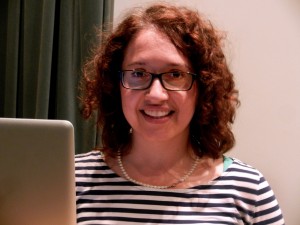October 1, 2012
CSI Universe: Space and Spectra
Dr Radmila Topalovic
Report by: Mike Meynell
For our first lecture of the 2012/13 season, the Flamsteed were delighted to welcome Dr Radmila Topalovic of the Royal Observatory Greenwich. Though Radmila had never lectured to us before, she was well known to many Flamsteed members, both through her work at the ROG and as tutor of the GCSE Astronomy course.
Radmila’s energetic and enthusiastic style kept us all thoroughly hooked throughout a wide-ranging lecture on the importance of spectroscopy in astronomy and how it has helped us in our understanding of the nature of the Universe.
Radmila began the lecture by saying that atomic spectra could be considered to be the ‘fingerprint’ of an element. It is possible to tell many different properties of objects by looking at this fingerprint.
We were then taken on a whistle-stop tour of the history of the Universe, with hydrogen, helium, lithium and beryllium created minutes after the Big Bang and stars producing all of the heavier elements in the periodic table, either through atomic fusion during their main sequence lifetime (for elements up to Iron) or via supernovae explosions of massive stars (for elements heavier than Iron).
The nature of light was then explained, with different types of light forming the entire electromagnetic spectrum, from gamma-rays at very short wavelengths to microwaves and radio waves at very long wavelengths.
So, what happens when light and matter interact? Radmila explained that electrons can move in several orbits, depending on the amount of energy absorbed by the atom. Photons can push electrons up to a higher energy, creating an absorption spectrum, which appears as ‘missing light’ or dark lines in the spectra. Emission spectrum are caused by atoms emitting photons of light, causing electrons to jump to a lower energy state.
By plotting the spectrum of an object, we can determine its temperature. A measurement of the ‘peak’ of an object’s spectrum gives an indication of the temperature of the object. Hotter stars have a peak in the blue end of the spectrum, whereas cooler stars have a peak in the red end.
We can also use spectra to determine the chemical make-up of plants on Earth. Radmila asked ‘why are plants green’? The answer is that plants contain the chemical chlorophyll, which has the property of reflecting green light and absorbing red, orange, blue and purple. Spectra are also used in medicine. For example, using spectroscopy to detect the chemical alanine is used as a diagnosis for brain tumours.
Spectra can also help us to understand how objects move. The Doppler effect shows that objects moving towards us have shorter wavelengths (i.e. the light is ‘blue-shifted’), whereas objects moving away have longer wavelengths (i.e. the light is ‘red-shifted’). We can determine that the Sun rotates by measuring the spectrum at each end of the Sun. This shows a red-shift on one side of the Sun and a blue-shift on the other, which confirms the Sun’s rotation.
Taking a spectrum of the Sun tells us that elements heavier than those that can be created in a star of the Sun’s size exist (for example, Iron). As the Sun cannot make these elements, they must have been made in another, bigger, star.
Radmila explained how spectra were used to determine that the Universe is expanding. Edwin Hubble, in the 1920s, was looking at light emitted by Hydrogen gas in galaxies. By measuring the spectra, he determined that all distant galaxies are moving away from us. In addition, the more distant the galaxy, the faster it was moving, showing that the Universe is expanding.
The age of the Universe has been determined at around 13.7 billion years by analysing the spectrum of the Cosmic Microwave Background radiation. Radmila also showed how the shape of the Milky Way can be determined by analysing the spin inversion of hydrogen gas in the spiral arms, thus allowing us to build a map of the Milky Way. The Doppler shift of the hydrogen gas shows us how fast the spiral arms are rotating. By analysing the rotation speed to that expected, given the amount of mass that we can see, shows that there would appear to be ‘missing mass’ in the Universe, which has been termed as ‘dark matter’.
Radmila then turned our attention to molecules. So far, 161 have been detected, such as Carbon Monoxide and Hydrogen Peroxide. A particularly interesting class of molecules are polycyclic aromatic hydrocarbons (PAHs), which are seen in nebulae. These molecules are important, as there is a theory that PAHs were the ‘scaffolding’ of the first DNA molecules.
Spectral evidence in asteroids and comets has shown that all of our water is extra-terrestrial in origin. Amino acids have been found in meteorites and it is also possible that bacteria could survive for long periods in space as we have found 250 million year-old dormant bacteria in the North Sea. The search for life goes on, with Curiosity on Mars finding evidence of an ancient stream of water only a few days ago.
Finally, Radmila ended by discussing the Kepler space observatory, which is designed to look for ‘Earth-like’ planets. So far, 838 exoplanets have been detected by various means. The exoplanet Kepler-22b is a planet larger than Earth, but within the ‘habitable’ zone of it’s Sun-line star. The next step must be to take a spectrum of the planet to see if water, methane and other building blocks of life can be detected.
This was an absolutely fascinating lecture that really highlighted the many varied uses of spectroscopy in astronomy and in areas closer to home. Our sincere thanks to Radmila for talking through such a wide-ranging topic in such a clear way. We hope she will come back to see us soon.
Pictures from the evening (by Grey Lipley):
Posted under: Flamsteed, Flamsteed Lecture, Meeting Report










You must be logged in to post a comment.